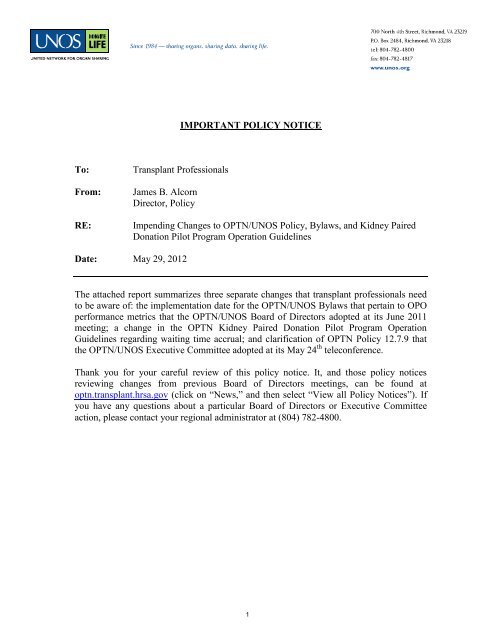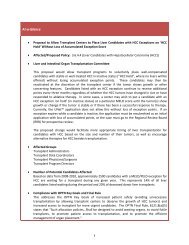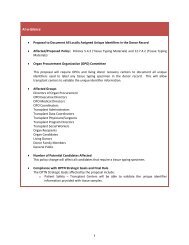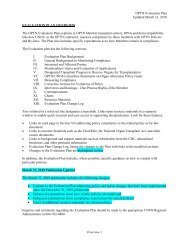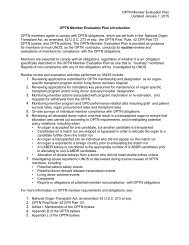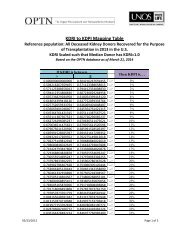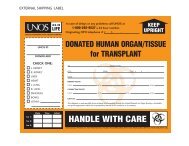modified cover memo- implementation dates - Organ Procurement ...
modified cover memo- implementation dates - Organ Procurement ...
modified cover memo- implementation dates - Organ Procurement ...
You also want an ePaper? Increase the reach of your titles
YUMPU automatically turns print PDFs into web optimized ePapers that Google loves.
IMPORTANT POLICY NOTICE<br />
To:<br />
From:<br />
RE:<br />
Transplant Professionals<br />
James B. Alcorn<br />
Director, Policy<br />
Impending Changes to OPTN/UNOS Policy, Bylaws, and Kidney Paired<br />
Donation Pilot Program Operation Guidelines<br />
Date: May 29, 2012<br />
The attached report summarizes three separate changes that transplant professionals need<br />
to be aware of: the <strong>implementation</strong> date for the OPTN/UNOS Bylaws that pertain to OPO<br />
performance metrics that the OPTN/UNOS Board of Directors adopted at its June 2011<br />
meeting; a change in the OPTN Kidney Paired Donation Pilot Program Operation<br />
Guidelines regarding waiting time accrual; and clarification of OPTN Policy 12.7.9 that<br />
the OPTN/UNOS Executive Committee adopted at its May 24 th teleconference.<br />
Thank you for your careful review of this policy notice. It, and those policy notices<br />
reviewing changes from previous Board of Directors meetings, can be found at<br />
optn.transplant.hrsa.gov (click on “News,” and then select “View all Policy Notices”). If<br />
you have any questions about a particular Board of Directors or Executive Committee<br />
action, please contact your regional administrator at (804) 782-4800.<br />
1
Table of Contents<br />
1. Model for Assessing the Effectiveness of Individual OPOs in Key Measures of <strong>Organ</strong> Re<strong>cover</strong>y<br />
and Utilization (Membership and Professional Standards Committee, <strong>Organ</strong> <strong>Procurement</strong><br />
<strong>Organ</strong>ization Committee) .......................................................................................................3<br />
Bylaw Language (Exhibit A) ...................................................................................................6<br />
2. Clarification of the Applicability of Policy 12.7.9 (Executive Committee) ...................................4<br />
Policy Language (Exhibit B)....................................................................................................9<br />
3. Revision to How Waiting Time Points Accrue in the OPTN KPD Pilot Program (Kidney<br />
Transplantation Committee) ......................................................................................................5<br />
OPTN KPD Pilot Program Operational Guidelines Language (Exhibit C)................................. 10<br />
2
Model for Assessing the Effectiveness of Individual OPOs in Key Measures of<br />
<strong>Organ</strong> Re<strong>cover</strong>y and Utilization<br />
Sponsoring Committees: Membership and Professional Standards Committee (MPSC) & <strong>Organ</strong><br />
<strong>Procurement</strong> <strong>Organ</strong>ization (OPO) Committee<br />
Bylaws Affected: Appendix B to the OPTN Bylaws, Section I. <strong>Organ</strong> <strong>Procurement</strong> <strong>Organ</strong>izations,<br />
F. Performance; and Appendix B to the UNOS Bylaws, Section I. <strong>Organ</strong> <strong>Procurement</strong><br />
<strong>Organ</strong>izations, G. Performance<br />
Distributed for Public Comment: January 2011<br />
Amended After Public Comment: Yes<br />
Effective Date: July 1, 2012<br />
Problem Statement<br />
The OPTN does not have a robust method for reviewing OPO performance. To address this, the<br />
OPTN/UNOS Board of Directors approved these bylaw changes at its June 2011 meeting. These changes<br />
will help the MPSC review OPO performance as it relates to aggregate and organ specific yield. Before<br />
these changes become effective, the Scientific Registry of Transplant Recipients (SRTR) must develop a<br />
report, and the members must then be notified of the exact <strong>implementation</strong> date.<br />
Changes<br />
These bylaws become effective on July 1, 2012. The MPSC will begin evaluating OPO performance during<br />
its July 2012 meeting.<br />
The bylaw changes allow the MPSC to systematically review OPOs and identify opportunities for<br />
improvement when an OPO’s observed performance falls below an expected performance<br />
threshold. The MPSC will identify an OPO for review (for all organs, as well as each organ type) if the<br />
OPO meets all three of the following criteria:<br />
• Observed organ yield per 100 donors - expected organ yield per 100 donors < -10;<br />
• A ratio of observed to expected yield is less than 0.90; and<br />
• A two-sided p-value less than 0.05.<br />
Action Required<br />
Be aware that these bylaw changes will be implemented on July 1, 2012. Members should review and<br />
become familiar with the bylaw changes.
Clarification of the Applicability of Policy 12.7.9<br />
Sponsoring Committee: Executive Committee<br />
Policy Affected: 12.7 (Standardized Packaging, Labeling and Transporting Of Living Donor<br />
<strong>Organ</strong>s, Vessels, and Tissue Typing Materials)<br />
Distributed for Public Comment: No<br />
Effective Date: July 1, 2012<br />
Problem Statement<br />
Current policy states that, “Policy 12.7 and its subsections apply only to living donor organs, tissue<br />
typing specimens, and vessels which are transported outside the re<strong>cover</strong>y facility.” However, a<br />
subsection of the policy (Policy 12.7.9) creates confusion because it states that it applies to organs that<br />
remain in the same re<strong>cover</strong>y facility as the intended candidate.<br />
Changes<br />
Policy 12.7 has been revised to state that the subsections apply only to living donor organs, tissue typing<br />
specimens and vessels that leave the facility, unless otherwise stated.<br />
Action Required<br />
Members should note that unless policy explicitly states otherwise, the requirements outlined in Policy<br />
12.7 and its subsections only apply to living donor organs, tissue typing specimens, and vessels which<br />
are transported outside the re<strong>cover</strong>y facility. For example, members must follow the existing<br />
verification requirements in Policy 12.7.9 when living donor organs do not leave the procurement<br />
facility.<br />
4
Revision to How Waiting Time Points Accrue in the OPTN KPD Pilot Program<br />
Sponsoring Committee: Kidney Transplantation Committee<br />
OPTN KPD Pilot Program Operational Guidelines Affected: Prioritization Points<br />
Distributed for Public Comment: No<br />
Effective Date: June 13, 2012<br />
Problem Statement<br />
The Kidney Paired Donation (KPD) Work Group and participating centers would prefer for KPD matches<br />
to be run more frequently. The current method of assigning waiting time points is based on the<br />
number of match runs and not calendar time, which means more frequent match runs will yield<br />
inconsistent KPD waiting time accrual across candi<strong>dates</strong>. Candi<strong>dates</strong>’ KPD waiting time points would<br />
depend on the number of matches run after they are entered into the KPD pilot program, not<br />
necessarily how long they had been waiting.<br />
Changes<br />
The accrual of KPD waiting time points has changed from 2 points per match run to 0.07 points per day<br />
(approximately 2 points per 30 days) in order to keep the relative value of KPD waiting time points the<br />
same if the match is run more often than once a month.<br />
KPD waiting time will begin when a candidate is added to the KPD system and accrues when a candidate<br />
is active or inactive.<br />
Action Required<br />
Members participating in the KPD Pilot Program should make themselves familiar with the systematic<br />
change pertaining to how KPD waiting time points will be accrued.<br />
5
Affected Bylaw Language:<br />
OPTN Bylaws:<br />
APPENDIX B TO BYLAWS<br />
Criteria for OPO, Transplant Hospital, and Histocompatibility Laboratory Membership<br />
I. <strong>Organ</strong> <strong>Procurement</strong> <strong>Organ</strong>izations.<br />
A. General. [No change to content, only to numbering convention.]<br />
B. Key Personnel. [No change to content, only to numbering convention.]<br />
C. Plan for Public Education on <strong>Organ</strong> Donation. [No change to content, only to numbering<br />
convention.]<br />
D. Communication of Information for <strong>Organ</strong> Distribution. [No change to content, only to<br />
numbering convention.]<br />
E. Donation After Cardiac Death: [No change to content, only to numbering convention.]<br />
F. Performance: The Membership and Professional Standards Committee (MPSC) will<br />
evaluate all OPOs to determine if the difference in observed and expected organ yield can be<br />
accounted for by some unique aspect of the Donation Service Area and/or OPO in question.<br />
The evaluation may include a peer visit to the OPO at the OPO’s expense.<br />
Those OPOs whose observed organ yield rates fall below the expected rates by more than a<br />
specified threshold will be reviewed. The absolute values of relevant parameters in the<br />
formula may be different for different organs, and may be reviewed and <strong>modified</strong> by the<br />
MPSC after distribution to the transplant community and subsequent Board approval.<br />
The initial criteria used to identify OPOs with lower than expected organ yield, for all organs<br />
as well as for each organ type, will include all of the following:<br />
• More than 10 fewer observed organs per 100 donors than expected yield (observed per<br />
100 donors - expected per 100 donors < -10)<br />
• A ratio of observed to expected yield less than 0.90,<br />
• A two-sided p-value is less than 0.05.<br />
All three criteria must be met for an OPO to be identified for MPSC review.<br />
If an OPO’s organ yield rate cannot be explained by donor mix or some other unique clinical<br />
aspect of the OPO or Donation Service Area in question, the Member, in cooperation with the<br />
MPSC, will adopt and promptly implement a plan for performance improvement. The<br />
Member’s failure to do so will constitute a violation of OPTN requirements.<br />
6
UNOS Bylaws:<br />
APPENDIX B TO BYLAWS<br />
Criteria for OPO, Transplant Hospital, and Histocompatibility Laboratory Membership<br />
I. <strong>Organ</strong> <strong>Procurement</strong> <strong>Organ</strong>izations.<br />
A. General. [No change to content, only to numbering convention.]<br />
B. Key Personnel. [No change to content, only to numbering convention.]<br />
C. Plan for Public Education on <strong>Organ</strong> Donation. [No change to content, only to numbering<br />
convention.]<br />
D. Communication of Information for <strong>Organ</strong> Distribution. [No change to content, only to<br />
numbering convention.]<br />
E. Donation After Cardiac Death: [No change to content, only to numbering convention.]<br />
F. Inactive Status. An organ procurement organization that is voluntarily inactive, declared<br />
inactive or withdrawn will no longer be allowed to list patients on the UNOS recipient list or<br />
to maintain a local recipient list in any form, and will not be allowed to provide organs to<br />
UNOS member transplant centers.<br />
G. Performance: The Membership and Professional Standards Committee (MPSC) will<br />
evaluate all OPOs to determine if the difference in observed and expected organ yield can be<br />
accounted for by some unique aspect of the Donation Service Area and/or OPO in question.<br />
The evaluation may include a peer visit to the OPO at the OPO’s expense.<br />
Those OPOs whose observed organ yield rates fall below the expected rates by more than a<br />
specified threshold will be reviewed. The absolute values of relevant parameters in the<br />
formula may be different for different organs, and may be reviewed and <strong>modified</strong> by the<br />
MPSC after distribution to the transplant community and subsequent Board approval.<br />
The initial criteria used to identify OPOs with lower than expected organ yield, for all organs<br />
as well as for each organ type, will include all of the following:<br />
• More than 10 fewer observed organs per 100 donors than expected yield (observed per<br />
100 donors - expected per 100 donors < -10)<br />
• A ratio of observed to expected yield less than 0.90,<br />
• A two-sided p-value is less than 0.05.<br />
All three criteria must be met for an OPO to be identified for MPSC review.<br />
If an OPO’s organ yield rate cannot be explained by donor mix or some other unique clinical<br />
aspect of the OPO or Donation Service Area in question, the Member, in cooperation with the<br />
MPSC, will adopt and promptly implement a plan for performance improvement. The<br />
Member’s failure to do so will constitute a violation of UNOS requirements.<br />
7
To read the complete UNOS bylaw language visit www.unos.org and select “UNOS bylaws” in the “I am<br />
looking for:” box in the upper left hand corner. To read the complete OPTN bylaw language visit<br />
optn.transplant.hrsa.gov, select the “Policy Management” tab, then select “OPTN Bylaws.”<br />
8
Affected Policy Language:<br />
12.7 Standardized Packaging, Labeling and Transporting Of Living Donor <strong>Organ</strong>s, Vessels,<br />
and Tissue Typing Materials<br />
Unless otherwise stated, Policy 12.7 and its subsections apply only when organs, tissue<br />
typing specimens, or vessels are re<strong>cover</strong>ed from living donors and transported outside<br />
the re<strong>cover</strong>y facility. The purpose of Policy 12.7 is to: and its subsections apply only to<br />
living donor organs, tissue typing specimens and vessels which are transported outside<br />
the re<strong>cover</strong>y facility and :<br />
state requirements for packaging and labeling living donor organs (when<br />
applicable), tissue typing specimens, and (when applicable) vessels, to prevent<br />
wastage (and/or to promote safe and efficient use);<br />
define terms and responsibilities related to packaging, labeling, and transporting<br />
organs of living donor organs, and if applicable living donor tissue typing specimens,<br />
and vessels; and<br />
state requirements for re<strong>cover</strong>ing, storing, and using (when applicable) living donor<br />
vessels.<br />
The responsibility for packaging and labeling living donor organs is assigned to the donor<br />
re<strong>cover</strong>y transplant center. If a living donor organ ever requires repackaging by a<br />
transplant center for transport, the transplant center will package, label and ship the<br />
organ in accordance with this policy.<br />
To read the complete policy language visit www.unos.org or optn.transplant.hrsa.gov. From the UNOS<br />
website, select “Policies” from the “I am looking for:” box in the upper left hand corner. From the OPTN<br />
website, select the “Policy Management” tab, then select “Policies.”<br />
9
Affected OPTN KPD Pilot Program Operational Guidelines Language:<br />
Prioritization Points<br />
1. Purpose: To describe the candidate characteristics and the match characteristics that receive<br />
priority or additional points in the Kidney Paired Donation Pilot Program<br />
2. Procedures:<br />
a. Each match between a candidate and potential living donor receives a base of 200<br />
points.<br />
b. Zero antigen mismatches between a potential living donor and a candidate receive an<br />
additional 200 points.<br />
c. Highly sensitized (e.g., probability of positive crossmatch≥ 80%) candi<strong>dates</strong> receive an<br />
additional 125 points.<br />
d. Candi<strong>dates</strong> who are prior living organ donors receive an additional 150 points.<br />
e. Pediatric (i.e., age < 18 years) candi<strong>dates</strong> receive an additional 100 points.<br />
f. Candi<strong>dates</strong> who have participated in previous match runs but did not receive a<br />
transplant receive an additional 2 points per match run. Candi<strong>dates</strong> entered in the OPTN<br />
KPD Pilot Program receive 0.07 points per day beginning on the day the candidate is<br />
added to the OPTN KPD Pilot Program.<br />
g. Matches between candi<strong>dates</strong> and potential living donors who are in the same region<br />
receive 25 points in addition to the base number of points.<br />
h. Matches between candi<strong>dates</strong> and potential living donors who are in the same donation<br />
service area (DSA) receive 50 points in addition to the base number of points.<br />
i. Matches between candi<strong>dates</strong> and potential living donors who are located at the same<br />
center receive 75 points in addition to the base number of points.<br />
j. Matches between candi<strong>dates</strong> and donors who have one or more of the candidate’s<br />
other antibody specificities receive -5 points.<br />
k. The waiting list candidate and the non-directed donor in a donor chain will be assigned<br />
no points.<br />
To read the complete OPTN Kidney Paired Donation Pilot Program Operational Guidelines visit<br />
optn.transplant.hrsa.gov, select the “Resources” tab, then select “Kidney Paired Donation Pilot<br />
Program.” On this page, select KPDPP Operational Guidelines.<br />
10


